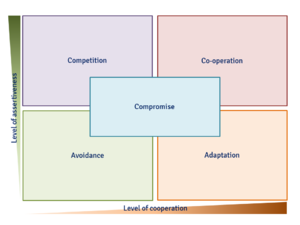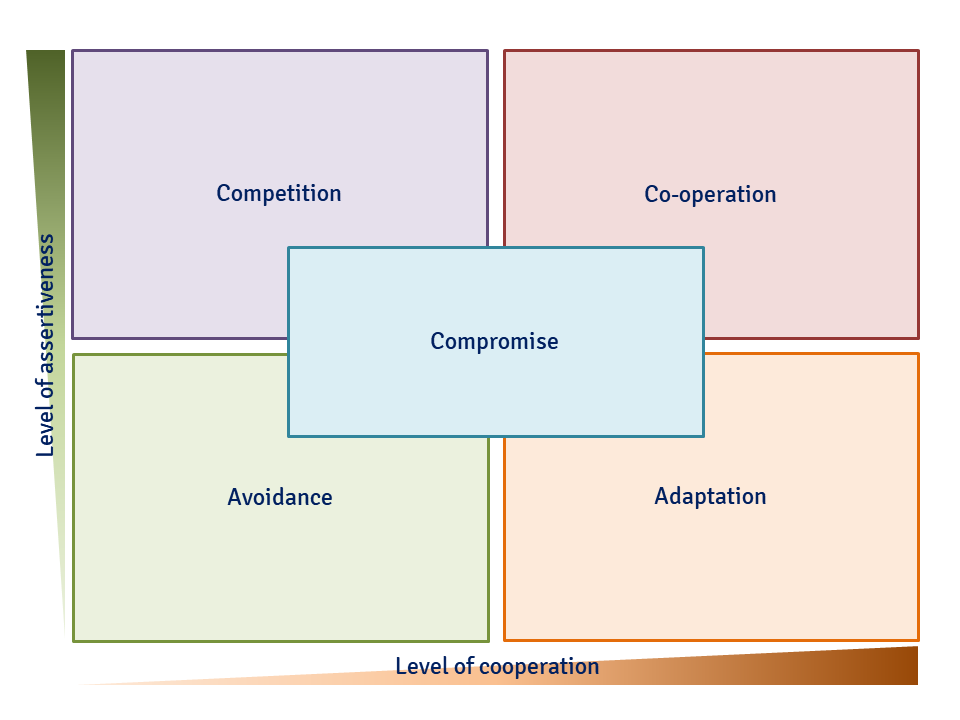Management by conflict
Management by conflict is a way of influencing the workers by various means, designed to counteract the effects of low activity, lack of commitment and low motivation. This management style stimulate internal initiative, action and development of creative problem-solving competences. Mary Parker Follett argued that the conflicts within the organization are quite normal and even thought that through them, managers could generate a valuable difference between parties of conflict, which lead to innovation.
Contents
- 1 Assumptions of management by conflict
- 2 Stages of preparation
- 3 Conflicts in process organization
- 4 Prevention of conflicts
- 5 Examples of Management by conflict
- 6 Advantages of Management by conflict
- 7 Limitations of Management by conflict
- 8 Other approaches related to Management by conflict
- 9 References
Assumptions of management by conflict
- conflicts in organizations are indispensable,
- values and objectives of individual members of the organization may be different,
- conflicts can help or harm the organization,
- management should manage conflict and resolve it in such a way that their intensity was maintained at the most optimal level,
Most prominent reasons for the conflicts are: Differences in gender, age, education, salary, or world-view. The vagueness of the tasks assigned, the lack of adequate information, the different ways of interpreting orders and injustice of managers.

Fig.1. Stages of conflit resolution
Stages of preparation
Conflict management involves first identifying the conflict and then choosing the right strategy of resolving it. We can distinguish five such strategies:
- co-operation - developing common solutions in order to find a similar point of view and induce a sense of winning for both sides of conflict,
- compromise, which is best achieved through negotiation, Each party will gain something, but also something will have to be given up,
- competition, assuming two choices - win or lose, used in extreme situations, e.g. when a decision has to be taken very quickly,
- adapting used most often in situations where the reason of conflict lies on the other side, or the case is much more important for us than for others,
- avoiding by simply not engaging in conflicts or taking on a passive attitude in anticipation that the conflict goes away.
Management by conflict is difficult to apply in practice. This style stimulates the organization, and, therefore, uses the creative potential of its members. In addition, it provides the ability to identify a man who consciously inhibits the growth of the company by pursuing his private goals. Management by conflicts can, however, contribute to a decline in results of the company, as well as weakening of commitment of employees. There is also substantial danger of self-destruction that even a small conflict can bring.
Conflicts in process organization
Process organization in is usually portrayed in a positive light in literature, it is presented as a model to the operation of businesses adapted to the rapidly changing environment. Authors points also out to the potential conflicts that may occur in the process organizations.
According to M. Hammer, the conflicts are characteristic to this organizational layout. Similarly G. Rummler and A. Brache, are pointing out that conflicts can arise between processes. In addition, developing teams pursuing the process may involve the employment of additional staff. Moreover, they add, that the organization functioning on the basis of a process structure can create barriers to the sharing of knowledge and resources.
Referring to the practice of the functioning of the process organization it could be noted that a common source of conflict is the lack of consequence during development and implementation of its objectives.
Another cause of conflicts is more liquid internal structure with the result that boundaries between processes could be brushed aside and then conflicts arise on the connections between one process team and another.
Prevention of conflicts
To eliminate the conflicts described above, or to limit their effect, it is proposed to:
- Devote sufficient time for training and creating awareness on the essence of creating a process organization,
- Create schedule of changes in the direction of the process organization,
- Consequence has been maintained during implementation,
- Developed change project for process organization should be comprehensive, that is, should contain the concepts of process as well as the elements of human and material resource management policy.
- Monitor changes and awareness of shortcomings in the implementation of processes.
Examples of Management by conflict
- Goal setting: Setting difficult but achievable goals for employees can help to create a sense of purpose, as well as encouraging them to work together to overcome any obstacles.
- Team Building: Engaging in team building activities and encouraging collaboration can help to foster a sense of unity and understanding among employees.
- Open Communication: Ensuring that there are open lines of communication between management and employees can help to encourage a sense of understanding and trust, while also allowing for disagreements to be voiced in a constructive way.
- Delegation: Giving employees clear tasks and allowing them to complete them without micromanagement can help to create a sense of ownership over their work, which can encourage them to take initiative and be more productive.
- Conflict Resolution: Putting in place clear procedures for resolving conflicts between employees can help to ensure that any disputes are addressed quickly and effectively. This can also help to create an environment where differences of opinion are seen as a positive thing rather than a source of conflict.
Advantages of Management by conflict
One of the advantages of Management by Conflict is that it can create a competitive and motivating work environment. This style of management can help to stimulate creativity and innovation, as employees are encouraged to find solutions to conflicts and problems. Furthermore, this style of management can also help to foster collaboration, as employees must work together to find solutions. Additionally, Management by Conflict can help to improve communication between employees, as they must discuss their differences and come to an agreement. Finally, this style of management can also help to build trust between employees, as they learn to respect each other’s opinions and work together. * Creates a competitive and motivating work environment
- Stimulates creativity and innovation
- Fosters collaboration
- Improves communication
- Builds trust between employees
Limitations of Management by conflict
- One of the main limitations of management by conflict is that it can lead to unnecessary tension, stress, and disruption within the organization. It can also lead to a lack of trust between team members and management.
- Management by conflict can also lead to decreased productivity, as employees are focused on the conflict rather than completing their tasks.
- This type of management is also known to be ineffective when it comes to resolving disputes. When the conflict is not managed properly, the parties involved in it will not reach a resolution and the problem will remain unresolved.
- Finally, management by conflict is not suitable for all organizations. It can be difficult to manage in a high-pressure environment and if not done correctly, it can lead to further conflict and disharmony.
- Collaborative problem solving - This approach involves both parties in the conflict working together to find solutions and generate a shared understanding of the issues.
- Transformative strategies - This approach encourages the parties to move away from a traditional win/lose mindset and instead develop solutions that are beneficial for both parties.
- Negotiation - This approach involves both parties working together to reach a mutually agreeable solution to the conflict.
- Mediation - This approach involves a neutral third party who helps the parties to identify and address the underlying issues of the conflict.
- Conflict resolution - This approach focuses on finding solutions that are acceptable to both parties and resolving the underlying issues of the conflict.
In conclusion, management by conflict is a style of management that encourages internal initiative, action and development of creative problem-solving competences. It is an effective way of dealing with conflicts within the organization. Other approaches related to management by conflict include collaborative problem solving, transformative strategies, negotiation, mediation and conflict resolution. Each of these approaches has its own strengths and can be used to reach a successful outcome.
| Management by conflict — recommended articles |
| Ability to work in a team — Team dynamics — Group norms — Organizational culture and project management — Importance of teamwork — Delegative leadership — Disadvantages of team work — Models of leadership — Advantages of team work |
References
- De Dreu, C. K. (1997). Productive conflict: The importance of conflict management and conflict issue. Using conflict in organizations, 9-22.
- Hopper, T. M. (1980). Role conflicts of management accountants and their position within organisation structures. Accounting, Organizations and Society, 5(4), 401-411.
- Robbins, S. P. (1978). "Conflict management" and "conflict resolution" are not synonymous terms. California Management Review, 21(2), 67-75.
- Thompson, J. D. (1960). Organizational management of conflict. Administrative Science Quarterly, 389-409.
- Thomas, K. W. (1992). Conflict and conflict management: Reflections and update. Journal of organizational behavior, 13(3), 265-274.

